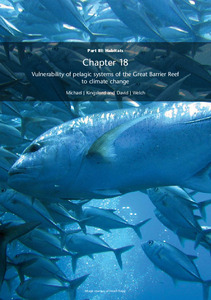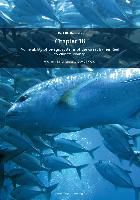Please use this identifier to cite or link to this item:
https://hdl.handle.net/11017/550

Full metadata record
| DC Field | Value | Language |
|---|---|---|
| dc.contributor.author | Kingsford, M.J. | * |
| dc.contributor.author | Welch, D.J. | * |
| dc.date.accessioned | 2012-08-10T00:27:17Z | null |
| dc.date.available | 2012-08-10T00:27:17Z | null |
| dc.date.copyright | 2007 | en |
| dc.date.issued | 2007 | en-US |
| dc.identifier.isbn | 9781876945619 | en |
| dc.identifier.uri | https://hdl.handle.net/11017/550 | null |
| dc.description.abstract | This review focuses on pelagic environments. The oceanography of the Great Barrier Reef (GBR) is dynamic and is the physical template to which organisms respond. Planktonic assemblages are the basis of pelagic food chains and they provide a rich supply of food for high trophic groups (eg fishes, birds and whales) as well as the larvae and adults of benthic assemblages (Figure 18.1). Changes in pelagic systems, therefore, cannot be viewed in isolation from other habitats (such as coral reefs). Plankton ranges from tiny viruses (less than 1 micron) and bacteria, to larger plant (phytoplankton) and animal plankton (zooplankton). | en |
| dc.publisher | The Great Barrier Reef Marine Park Authority | en |
| dc.relation.ispartofseries | Book: Climate change and the Great Barrier Reef: a vulnerability assessment | en |
| dc.relation.uri | https://hdl.handle.net/11017/137 | en |
| dc.title | Chapter 18: Vulnerability of pelagic systems of the Great Barrier Reef to climate change | en |
| dc.type | Book section or chapter | * |
| dc.subject.asfa | Climatic changes | en |
| dc.subject.asfa | Coral reefs | en |
| dc.subject.asfa | Ecosystem resilience | en |
| dc.subject.asfa | Pelagic environment | en |
| dc.description.notes | This is Chapter 18 of Climate change and the Great Barrier Reef: a vulnerability assessment. The entire book can be found at http://hdl.handle.net/11017/137 | en |
| dc.contributor.corpauthor | Great Barrier Reef Marine Park Authority | en |
| dc.bibliographicCitation.title | Climate change and the Great Barrier Reef: a vulnerability assessment | en |
| dc.bibliographicCitation.stpage | 555 | en |
| dc.bibliographicCitation.endpage | 592 | en |
| dc.bibliographicCitation.authors | Johnson, J.E. | * |
| dc.bibliographicCitation.authors | Marshall, P.A. | * |
| dc.subject.apais | Environmental management | en |
| dc.subject.apais | Environmental impact | en |
| dc.publisher.place | Townsville | en |
| dc.relation.connectiontogbrmpa | GBRMPA published this item | en |
| dc.subject.category | Animals | en |
| dc.subject.category | Plants | en |
| dc.subject.category | Ecosystems | en |
| dc.subject.category | Processes | en |
| dc.subject.category | Economic values | en |
| dc.subject.category | Social values | en |
| dc.subject.category | Climate change | en |
| dc.subject.category | Coastal communities | en |
| dc.subject.location | Reef-wide | en |
| dc.keywords | Climate change action plan 1 | en |
| dc.keywords | CCAP output | en |
| dc.keywords | CCAP 07/08 | en |
| dc.keywords | resilient GBR ecosystem | en |
| dc.keywords | targeted science | en |
| dc.keywords | Vulnerability assessment | en |
| dc.keywords | A1 | en |
| dc.keywords | A1.2 | en |
| dc.keywords | A1.3 | en |
| dc.keywords | A1.4 | en |
| dc.keywords | B1 | en |
| dc.keywords | B1.3 | en |
| dc.keywords | B1.4 | en |
| dc.keywords | pelagic | en |
| Appears in Collections: | Effects | |
Files in This Item:
| File | Description | Size | Format | |
|---|---|---|---|---|
| Chapter-18-Vulnerability-of-pelagic-systems-of-the-Great-Barrier-Reef-to-climate-change.pdf | 706.59 kB | Adobe PDF |  View/Open |
Items in ELibrary are protected by copyright, with all rights reserved, unless otherwise indicated.
